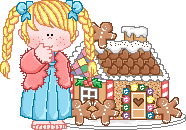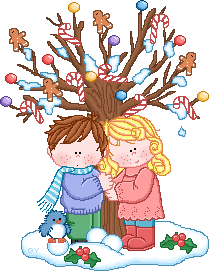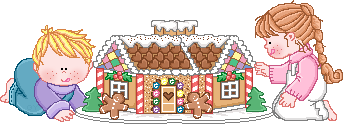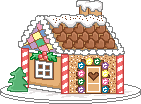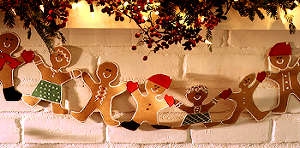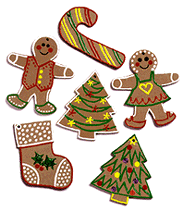Gingerbread
has been baked in Europe for centuries. In some
places, it was a soft, delicately spiced cake; in
others, a crisp, flat cookie, and in others, warm,
thick, steamy-dark squares of "bread,"
sometimes served with a pitcher of lemon sauce or
whipped cream. It was sometimes light, sometimes
dark, sometimes sweet, sometimes spicy, but it was
almost always cut into shapes such as men, women,
stars or animals, and colorfully decorated or stamped
with a mold and dusted with white sugar to make the
impression visible.
The
term may be imprecise because in Medieval England
gingerbread meant simply "preserved ginger"
and was a corruption of the Old French gingebras,
derived from the Latin name of the spice, Zingebar.
It was only in the fifteenth century that the term
came to be applied to a kind of cake made with
treacle and flavored with ginger.
Ginger
was also discovered to have a preservative effect
when added to pastries and bread, and this probably
led to the development of recipes for ginger cakes,
cookies, Australian gingernuts and flavored breads.
The
manufacture of gingerbread appears to have spread
throughout Western Europe at the end of the eleventh
century, possibly introduced by crusaders returning
from wars in the Eastern Mediterranean. From its very
beginning gingerbread has been a fairground delicacy.
Many fairs became known as "gingerbread fairs"
and gingerbread items took on the alternative name in
England of "fairings" which had the generic
meaning of a gift given at, or brought from, a fair.
Certain shapes were associated with different seasons:
buttons and flowers were found at Easter fairs, and
animals and birds were a feature in Autumn. There is
also more than one village tradition in England
requiring unmarried women to eat gingerbread "husbands"
at the fair if they are to stand a good chance of
meeting a real husband. Of course, you could always
visit Elizabeth Botham & Sons, a family-run craft
bakery on the North Yorkshire coast of England, and
sample some authentic pastries.
If
you lived in London in 1614, your family would have
gone to the Bartholomew Fair on August 24. Of the
special cakes prepared for holidays and feasts in
England, many were gingerbread. If a fair honored a
town's patron saint, e.g., St. Bartholomew, the
saint's image might have been stamped (and even
gilded) into the gingerbread you would buy. If the
fair were on a special market day, the cakes would
probably be decorated with an edible icing to look
like men, animals, valentine hearts or flowers.
Sometimes the dough was simply cut into round "snaps."
Gingerbread-making
was eventually recognized as a profession in itself.
In the seventeenth century, gingerbread bakers had
the exclusive right to make it, except at Christmas
and Easter. Their street cries could be heard well
into the nineteenth century, but in 1951, writer
Henry Mayhew sadly recorded that "there are only
two men in London who make their own gingerbread nuts
for sale in the streets."
Of
all the countries in Europe, Germany is the one with
the longest and strongest tradition of flat, shaped
gingerbreads. At every autumn fair in Germany, and in
the surrounding lands where the Germanic influence is
strong, there are rows of stalls filled with hundreds
of gingerbread hearts, decorated with white and
colored icing and tied with ribbons.
If
you lived in Nuremberg in 1614, your family would
have gone to the Christkindlmarkt in December. You
would have bought carved Christmas decorations,
special sausages, and the famous Nuremberg Lebkuchen
flavored with ginger, which you probably would have
thought was the best in the world. Nuremberg
gingerbread was not baked in the home, but was the
preserve of an exclusive Guild of master bakers, the
Lebkuchler.
Nuremberg
became known as the "gingerbread capital"
of the world and as with any major trading center,
many fine craftsmen were attracted to the town.
Sculptors, painters, woodcarvers and goldsmiths all
contributed to the most beautiful gingerbread cakes
in Europe. Gifted craftsmen carved intricate wooden
molds, artists assisted with decoration in frosting
or gold paint. Incredibly fancy hearts, angels,
wreaths and other festive shapes were sold at fairs,
carnivals and markets.
Lebkuchen
are made throughout Germany and large pieces of
lebkuchen are used to build Hexenhaeusle ("witches'
houses," from the fairy tale Hansel and Gretel,
also called Lebkuchenhaeusel and Knusperhaeuschen—"houses
for nibbling at").
Nuremberg
merchants, in fact, were so well known for their
spices that they had the nickname "pepper sacks."
From early on, Nuremberg's Lebkuchen packed into one
recipe all the variety of flavorings available to its
bakers—cardamom, cloves, cinnamon, white pepper,
anise and ginger.
The
traditions in France were closer to the German than
the English ones, with noteworthy recipes for pain
d'epices coming from Dijon, Reims and Paris. In 1571,
French bakers of pain d'epices even won the right to
their own guild, or professional organization,
separate from the other pastry cooks and bakers. In
Paris a gingerbread fair was held from the eleventh
century until the nineteenth century at an abbey on
the site of the present St. Antoine Hospital, where
monks sold gingerbread cut into the shape of pigs.
During
the nineteenth century, gingerbread was both
modernized and romanticized. When the Grimm brothers
collected volumes of German fairy tales they found
one about Hansel and Gretel, two children who,
abandoned in the woods by destitute parents,
discovered a house made of bread, cake and candies.
By the end of the century the composer Englebert
Humperdink wrote an opera about the boy and the girl
and the gingerbread house.
At
Christmas, gingerbread makes its most impressive
appearance. The German practice of making lebkuchen
houses never caught on in Britain in the same way as
it did in North America, and it is here still that
the most extraordinary creations are found. Elaborate
Victorian houses, heavy with candies and sugar
icicles, vie in competition with the Hansel and
Gretel houses, more richly decorated and ornamented
than most children could imagine in their wildest
dreams.
Gingerbread
making in North America has its origins in the
traditions of the many settlers from all parts of
Northern Europe who brought with them family recipes
and customs. By the nineteenth century, America had
been baking gingerbread for decades.
American
recipes usually called for fewer spices than their
European counterparts, but often made use of
ingredients that were only available regionally.
Maple syrup gingerbreads were made in New England,
and in the South sorghum molasses was used.
Regional
variations began occurring as more people arrived. In
Pennsylvania, the influence of German cooking was
great and many traditional Germany gingerbreads
reappeared in this area, especially at Christmas time.
The
North and Midwest of America welcomed the Northern
and Middle Europeans. At Christmas it is still very
common in the midwest to have Scandinavian cookies
like Pepparkaker or Lebkuchen. Often one can find
wives holding "coffee kolaches" (coffee
mornings) at which European ginger cakes still reign.
Nowhere
in the world is there a greater repertoire of
gingerbread recipes than in America —there are
so many variations in taste, form and presentation.
With the rich choice of ingredients, baking aids and
decorative items the imaginative cook can create the
most spectacular gingerbread houses and centerpieces
ever.







